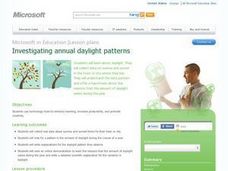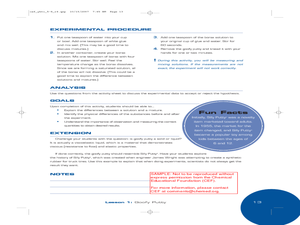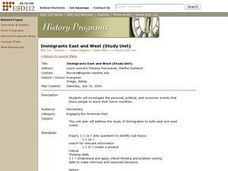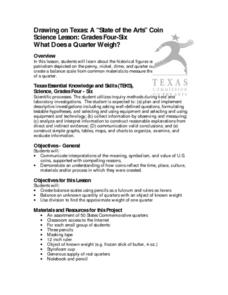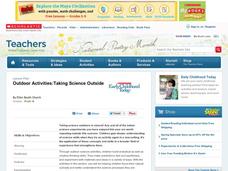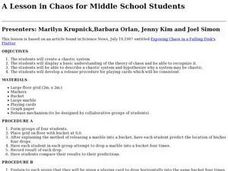Curated OER
Investigating daylight
students investigate a natural factor affecting their everyday lives: daylight. First, they collect data on sunrise and sunset in their hometown, create a Microsoft Office Excel chart to help them understand the data pattern, and offer a...
Curated OER
Goofy Putty
Students examine mixtures and solution properties by making a borax polymer. In this chemical reactions lesson, students make a putty out of borax solution mixed to create a polymer.
Curated OER
Immigrants East and West
Pupils investigate the personal, political and economic events that drove people to leave their home countries. They research Chinese migrations in the 1800s and the English migrations in the 1600s. They create an identity based on...
Curated OER
Compare and Contrast
Third graders compare the past and present daily life of West Bloomfield and Wilmington, North Carolina using narratives and graphic data. The create a table comparing and contrasting the two communities.
Curated OER
What Does a Quarter Weigh?
Students study the historical figures and symbols of U.S.
patriotism depicted on the penny, nickel, dime, and quarter coins. They
create a balance scale from common materials to measure the approximate weight
of a quarter.
Curated OER
Outdoor Activities: Taking Science Outside
Students participate in various outdoor science activities to enhance their observation, classification, and analysis skills. In this outdoor lesson, students begin by observing a tree from a straightforward angle, then from the...
Curated OER
New Jersey Estuaries
Students experiment to discover that salt water is denser than fresh water by creating color coded solutions. They examine how heavy rainstorms and high tides develop layers of different degrees of density.
Curated OER
Great Questions for Tic Tac Toe
Fourth graders plan their own activities to reinforce the concepts being taught in school. The tic-tac-toe grid is used to help students create innovative learning activities to generate ideas.
Curated OER
Art: Mirror Of History
Learners show through art how major human events have changed American Culture. Students write in a journal to keep track of studying that is done during the unit. They also create an oral report.
Curated OER
Numerical Determination of Drag Coefficients
Learners create a video of an object falling with a drag. In this physics instructional activity, students calculate drag coefficient using data from Logger Pro. They calculate velocity and acceleration of the object.
Curated OER
Passport to the Eastern Hemisphere
Seventh graders create a time line of significant dates in the history of their nation. This requires students to examine the entire history of a country and make informed judgments based on their historical knowledge.
Curated OER
"I am Not Well": Unspoken Endings and Unscripted Scenes
Students analyze Act 4, scene 1 from the play, Merchant of Venice. They hypothesize the content of an unscripted moment and response, look for evidence in the text to support their hypothesis, rewrite the scene, and perform it for the...
Curated OER
OUtside Influence
Students identify factors that are important for brain functioning of learning. They observe the impact of interaction in mice. They also create their own experiment dealing with the mice. They analyze and share their results.
Curated OER
LAB: Temperature Inversion - Pollution Simulation
Students, after identifying and examining the relationship of temperature and air masses in association with smog and pollution, create a temperature inversion in a long aquarium jar. They experience what happens when smog builds up and...
Curated OER
Graphing the Elephant Seal Population Data
Students are able to graph data that they generated in the elephant seal exercise using proper format and labeling. They are able to interpret the graphs they created and make A) conclusions, and B) predictions based on that graph.
Curated OER
Bubbles
Students complete experiments with three different bubble solutions to determine which one creates the largest bubbles. Before conducting the experiments, they discuss the ingredients in each solution, and make predictions on which will...
Curated OER
A Lesson in Chaos for Middle School Students
Students create a chaotic system. They display a basic knowledge of the system and are able to recognize it. The students form a hypothesis about a chaotic system and theorize the cause and effect.
Curated OER
The Atlatl System
Fifth graders are introduced to the atlatl system and how to test and control variables. In groups, they use the Internet to research how the system has changed over time. They test various variables and record their results in a graph...
Curated OER
Force Counterforce
Middle schoolers hypothesize what forces affect the motion of a falling body. In this physical science lesson, students create diagrams and illustrations to support their hypothesis. They perform the experiment and record observations.
Curated OER
Medicine Show
Students gather anecdotal evidence about various herbal remedies' abilities to cure ailments, develop hypotheses from these observations, and design scientifically valid experiments that could prove their suppositions.
Curated OER
Volcanic Wrath
Students observe volcanic action using an internet Web site of satellite photographs. Stuents create a portfolio of observable features.
Curated OER
Flying the Friendly Skies
Students investigate aerodynamics by comparing and contrasting the flight of two gliders. They make prediction and observation charts and test a variety of hypotheses using paper gliders.
Curated OER
Bird Beak Anatomy
Third graders participate in an activity to determine which tool will work the best to gather food. They create analogies about how the experiment relates to birds. They brainstorm about which adaptation helps or hurts the survival of an...
Curated OER
World's Most Dynamic Force
Young scholars explore the Earth's forces. They review an assessment task and its accompanying rubric. They classify ten items as long-term or short-term interactions of the Earth's components and rank the destructive impact of the...
